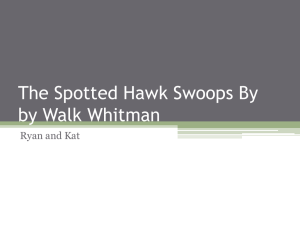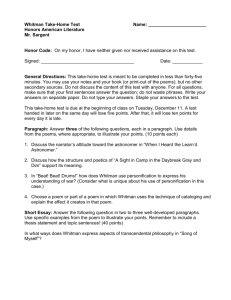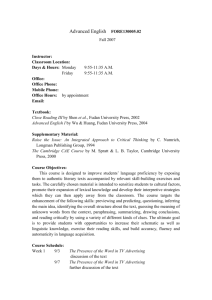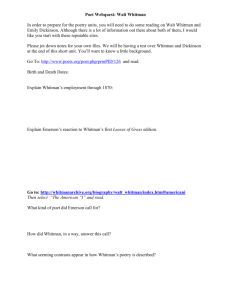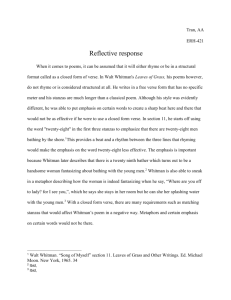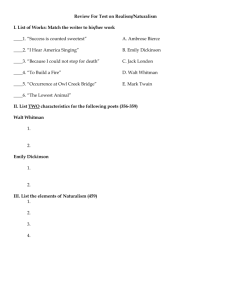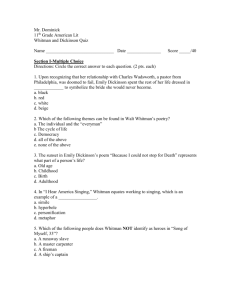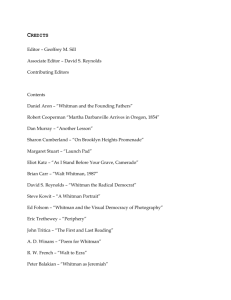'A Poet Given to Compulsive Self-Revision': Reflections on Walt
advertisement
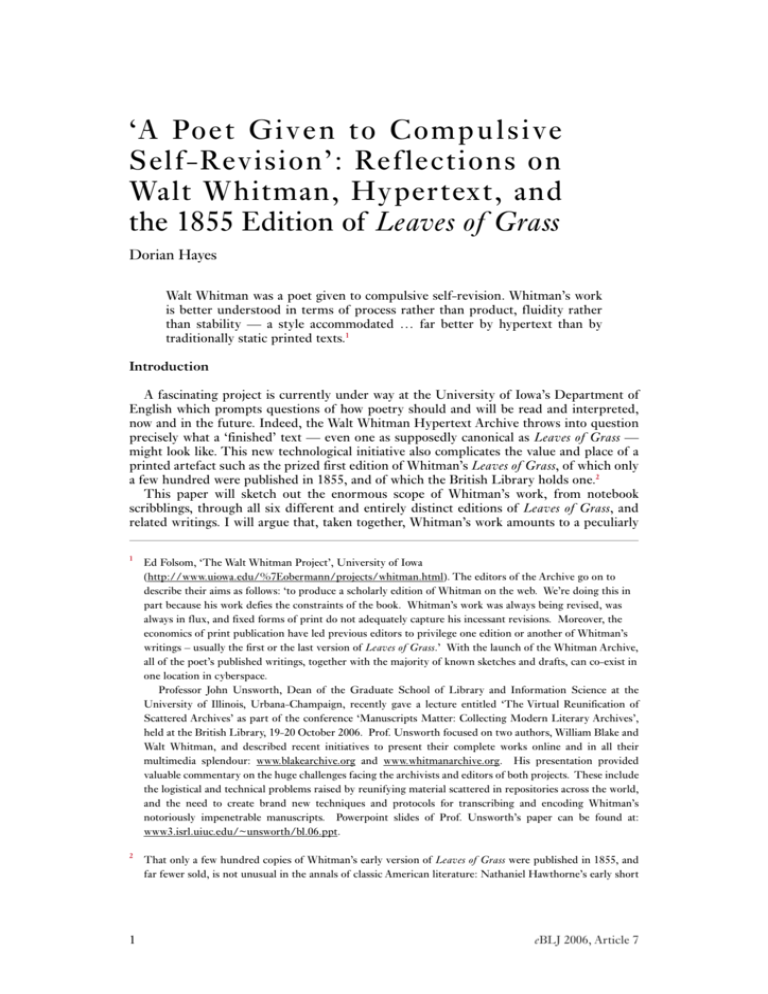
‘A Poet Given to Compulsive Self-Revision’: Reflections on Walt Whitman, Hypertext, and the 1855 Edition of Leaves of Grass Dorian Hayes Walt Whitman was a poet given to compulsive self-revision. Whitman’s work is better understood in terms of process rather than product, fluidity rather than stability — a style accommodated … far better by hypertext than by traditionally static printed texts.1 Introduction A fascinating project is currently under way at the University of Iowa’s Department of English which prompts questions of how poetry should and will be read and interpreted, now and in the future. Indeed, the Walt Whitman Hypertext Archive throws into question precisely what a ‘finished’ text — even one as supposedly canonical as Leaves of Grass — might look like. This new technological initiative also complicates the value and place of a printed artefact such as the prized first edition of Whitman’s Leaves of Grass, of which only a few hundred were published in 1855, and of which the British Library holds one.2 This paper will sketch out the enormous scope of Whitman’s work, from notebook scribblings, through all six different and entirely distinct editions of Leaves of Grass, and related writings. I will argue that, taken together, Whitman’s work amounts to a peculiarly 1 Ed Folsom, ‘The Walt Whitman Project’, University of Iowa (http://www.uiowa.edu/%7Eobermann/projects/whitman.html). The editors of the Archive go on to describe their aims as follows: ‘to produce a scholarly edition of Whitman on the web. We’re doing this in part because his work defies the constraints of the book. Whitman’s work was always being revised, was always in flux, and fixed forms of print do not adequately capture his incessant revisions. Moreover, the economics of print publication have led previous editors to privilege one edition or another of Whitman’s writings – usually the first or the last version of Leaves of Grass.’ With the launch of the Whitman Archive, all of the poet’s published writings, together with the majority of known sketches and drafts, can co-exist in one location in cyberspace. Professor John Unsworth, Dean of the Graduate School of Library and Information Science at the University of Illinois, Urbana-Champaign, recently gave a lecture entitled ‘The Virtual Reunification of Scattered Archives’ as part of the conference ‘Manuscripts Matter: Collecting Modern Literary Archives’, held at the British Library, 19-20 October 2006. Prof. Unsworth focused on two authors, William Blake and Walt Whitman, and described recent initiatives to present their complete works online and in all their multimedia splendour: www.blakearchive.org and www.whitmanarchive.org. His presentation provided valuable commentary on the huge challenges facing the archivists and editors of both projects. These include the logistical and technical problems raised by reunifying material scattered in repositories across the world, and the need to create brand new techniques and protocols for transcribing and encoding Whitman’s notoriously impenetrable manuscripts. Powerpoint slides of Prof. Unsworth’s paper can be found at: www3.isrl.uiuc.edu/~unsworth/bl.06.ppt. 2 That only a few hundred copies of Whitman’s early version of Leaves of Grass were published in 1855, and far fewer sold, is not unusual in the annals of classic American literature: Nathaniel Hawthorne’s early short 1 eBLJ 2006, Article 7 ‘A Poet Given to Compulsive Self-Revision’: Reflections on Walt Whitman Fig. 1. Walt Whitman, Leaves of Grass (Brooklyn, 1855), title page. BL, C.58.g.4. stories, and first novel, Fanshawe (1828), were self-published and went almost entirely ignored by the reading public (see John Idol, ‘Nathaniel Hawthorne’, Dictionary of Literary Biography, vol. xxiii: The American Renaissance in New England, ed. Wesley Mott (New York, 2000), pp. 88-101). Similarly small print-runs and readership figures characterized Herman Melville’s early novels — Typee (1846), Omoo (1847), and Mardi 2 eBLJ 2006, Article 7 ‘A Poet Given to Compulsive Self-Revision’: Reflections on Walt Whitman intertextual, or even ‘hypertextual’ oeuvre. There will follow a close textual analysis of some key passages from the first (1855) edition of Leaves of Grass, and a consideration of the effects of reading this already multivalent, hybrid text in a ‘virtual environment’. Finally, I shall offer my observations on aspects of literary interpretation and reception which are thrown into sharp relief in the light of these digital innovations. ‘Democratic Vistas’: The Hypertextual Walt Whitman As numerous critics have pointed out, Whitman’s work is uniquely suited to a modern, ‘hypertextual’ re-presentation. As noted above, the poet was ‘given to compulsive selfrevision’ throughout his literary career. From his earliest notebooks begun in the 1850s, through the life-changing ravages of the Civil War and the bitter Reconstruction years, all the way forward to the sixth, so-called ‘death-bed’ edition published just before his actual death in 1892, Leaves of Grass expanded from a slim 95-page volume to a vast and sprawling 450-page opus. Aside from Leaves of Grass and the later Annexes of A Passage to India (1871) and others, Whitman was also a prodigious prose-writer (principal works include Democratic Vistas [1870] and Specimen Days [1882]), correspondent, and sketch-writer. In addition to Whitman’s frequent prolixity, habitual revisions and re-orderings of major works, editorial rigour, and rhetorical experimentation, the sheer quantity of text amounts to something of an archivist’s nightmare — his collected published works run to twenty-two volumes alone, to say nothing of the ever-expanding quantity of manuscript material unearthed year on year! Describing their original intentions in creating the Whitman Hypertext Archive, academic Kenneth Price asserts that: Whitman’s writings defy the constraints of the book. Documents associated with a Whitman poem might well include an initial prose jotting containing a key image or idea; trial lines in a notebook; a published version appearing in a periodical; corrected page proofs; and various printed versions of the poem appearing in books, including (but not limited to) the six distinct editions of Leaves of Grass. (1847) — , although Moby Dick (1851) fared considerably better (see Henig Cohen, ‘Herman Melville’, Dictionary of Literary Biography, vol. iii: Ante-Bellum in New York and the South, ed. Joel Myerson (New York, 1979), pp. 221-45). Henry David Thoreau —another of Whitman’s now-celebrated contemporaries — had perhaps the least auspicious start to his publishing career: A Week on the Concord and Merrimack Rivers was published (by James Munroe & Co., of Boston) in an initial run of 1,000 in 1849; unfortunately for Thoreau, only 200 had been sold by 1853. It was for this reason that no publisher would consider the author’s Walden manuscript, a fact which led Thoreau to spend seven years revising and re-editing it before eventual publication in 1854. Even then, the figures remained disappointing: Ticknor & Fields in Boston printed 2,000 copies of Walden, which took five years to sell out; the book was only republished after Thoreau’s death in 1862 (see Walter Harding, ‘Henry David Thoreau’, Dictionary of Literary Biography, vol. i: The American Renaissance in New England (New York, 1978), pp. 170-82). Like many of these cornerstones of American literature, Whitman’s Leaves of Grass (1855) was published at the poet’s own expense, since no commercial house was prepared to take the financial risk (Bettina Knapp, Walt Whitman (New York, 1993), p. 36). On the other hand, another contemporary of Whitman, this time a spokesman for the conservatism of ‘Victorian America’, Henry Wadsworth Longfellow, was enormously popular from the outset of his career, his early poetry appearing in newspapers and journals to great acclaim, before being anthologized in Voices of the Night (1839) and Ballads and other Poems (1841). Voices, in particular, was a contemporary publishing phenomenon, going through six editions in two years and becoming famous to thousands of readers (see Steven Allaback, ‘Henry Wadsworth Longfellow’, Dictionary of Literary Biography, vol. i: The American Renaissance in New England, pp. 117-23). It is worth pointing out that edition quantities of new books during the nineteenth 3 eBLJ 2006, Article 7 ‘A Poet Given to Compulsive Self-Revision’: Reflections on Walt Whitman Price goes on to argue that ‘the fixed forms of print are cumbersome and inadequate for capturing Whitman’s numerous and complex revisions’. Meanwhile, Price’s University of Iowa colleague, Ed Folsom, suggests that ‘the form and structure of hypertext are particularly appropriate and useful for studying Whitman’: We finally have a technology that can capture Whitman’s incessant alterations of his poetry … Archives are filled with copies of his printed texts on which he has added handwritten alterations. Working through these documents becomes an exercise in hypertext. You see a poem changing, word by word, line by line, edition by edition.3 With these observations, Folsom and Price mount a robust editorial justification of the need for a Whitman archive online. Their insights echo the promotional drive of other pioneering digitization projects, including some produced (or co-produced) by the British Library, such as the extensive Online Gallery pages, and the International Dunhuang Project.4 So, how does the experience of using hypertexts of this kind work in practice? How does it compare with the seemingly anachronistic experience of reading the ‘original’ paper texts? Can the two media be used together — indeed does this act of juxtaposition serve to enrich the process? ‘When I Read the Book’: Re-reading Leaves of Grass (1855) The American poets are to enclose old and new for America is the race of races. Of them a bard is to be commensurate with a people …. The greatest poet has less a marked style and is more the channel of thoughts and things without increase or diminution, and is the free channel of himself.5 Such was Whitman’s injunction to himself and his fellow ‘American poets’ of the antebellum years in the Preface to the 1855 edition of Leaves of Grass. True to his word, Whitman’s corpus contains some of the freest and most inventive, ingenious poetry of its time, and a flowing, long-lined style that has influenced practically every development in American literature over the last 150 years. From Whitman a direct line of thought and articulation can be traced through the writings of Hart Crane and e. e. cummings, the free verse of Beat poets like Ginsberg, Ferlinghetti, and O’Hara, and the more recent prose poetry of Raymond Carver and August Kleinzahler. In many ways, the opening of Leaves of Grass, like the Preface quoted above, reads — and, just as importantly, looks — like a declaration of literary independence: 3 4 5 4 century were significantly lower than is common today, largely owing to the relative cost of printing and much smaller reading public. According to Philip Gaskell’s New Introduction to Bibliography (Oxford, 1974), ‘most new books [were] published in small editions, the first printing of works of fiction, history, biography, travel, etc., still being normally in the range of 750-1,250 copies, with only authors of the stature of Dickens or Tennyson running to 5-figure quantities in their lifetime’ (p. 304; see also pp. 304-7). Kenneth Price, ‘Dollars and Sense in Collaborative Digital Scholarship: The Example of Walt Whitman Hypertext Archive’ (2001), Walt Whitman Hypertext Archive (http://www.whitmanarchive.org/introduction/). See http://www.bl.uk/onlinegallery/homepage.html and http://idp.bl.uk. Whitman, ‘Preface’, Leaves of Grass (Brooklyn, NJ: printed by J. and T. Rome, 1855), pp. iv, vii. eBLJ 2006, Article 7 ‘A Poet Given to Compulsive Self-Revision’: Reflections on Walt Whitman Fig. 2. Walt Whitman, Leaves of Grass (1855), ll. 1-5. BL, C.58.g.4.6 From the very opening lines, then, the speaking persona of Leaves of Grass makes a radical assertion of his unique identity. As Ivan Marki puts it, ‘that identity, rather than any argument, is the true significance of the volume; that is what it means’: The topics and themes taken up by the poems are components of the speaker’s personality, and the order in which they are arranged does not so much advance propositions leading toward a reasoned conclusion as it discloses the dynamism through which that personality is constituted.7 Opening the slightly tatty, stained, and foxed British Library copy of Leaves of Grass, smelling its history and sensing the many hands through which it has passed (including the poet’s own), it nevertheless remains difficult to re-capture the sheer impact and thrill that this lazy, ‘loafing’ statement of intent must have had in the volatile city of New York into which it was launched in 1855. Harder still to quantify is the effect that such a work — with its embattled belief in the power and potential of an American future — might have had in the cynical atmosphere of literary London. 6 7 5 Interestingly, according to the poet’s most recent biographer, this first page of Leaves of Grass was in fact set to type by Whitman himself (Jerome Loving, Walt Whitman: The Song of Himself (Los Angeles, 1999), pp. 181-2). Ivan Marki, ‘Leaves of Grass, 1855 edition’, Walt Whitman Hypertext Archive, http://www.whitmanarchive.org/archivephp/criticism/criticismframeset.php?id=44. Marki elaborates further on the 1855 edition of Leaves of Grass in The Trial of the Poet: An Interpretation of the First Edition of ‘ Leaves of Grass’ (New York, 1976). eBLJ 2006, Article 7 ‘A Poet Given to Compulsive Self-Revision’: Reflections on Walt Whitman Fig. 3. Whitman invoice; Leaves of Grass is listed as item no. 19. Note that — as was the case with most booksellers then (and now) — the materials on this list were initially supplied ‘on approval’. BL Corporate Archive (DH5/16 Department of Printed Books: In Letters, 1875). 6 eBLJ 2006, Article 7 ‘A Poet Given to Compulsive Self-Revision’: Reflections on Walt Whitman It was, however, precisely this act of historical re-imagining that was required when Professor Folsom invited the British Library to participate in a census of all extant 1855 printings or ‘issues’ of the text. According to Whitman scholar William White, 795 copies of the first Leaves of Grass were produced in the print-shop of James and Thomas Rome in Brooklyn, New Jersey in 1855. Of these, a very small number were distributed in the UK by William Horsell of London, and far fewer have survived into the 21st century.8 As the census questionnaire made clear, there were numerous differences of ‘state’ among these 795 copies, from small typographical or grammatical changes to substantial extra materials tipped- or pasted-in to the inner covers. From this we can deduce that these were variants from the basic form of the original or ‘ideal’ copy, as opposed to a distinct and ‘purposeful publishing unit removed from the initial issue’, which would otherwise be classed as a ‘separate issue’.9 For obvious reasons, the most notable variants — and therefore among the 8 9 7 ‘The First (1855) Leaves of Grass: How Many Copies?’, Papers of the Bibliographical Society of America, lvii (1963), pp. 352-4. According to receipts held by the British Library’s Corporate Information Management Unit (CIMU), the BL copy was purchased from Mr George Rivers, as part of a larger consignment of books, for £2 and 2 shillings, or 2 guineas, on 8 July 1857. The invoice entry from the records of the British Museum Library (the forerunner of the British Library) suggests that, although he sadly lost his sight entirely in 1901, William Brenchley Rye, Keeper of Printed Books between 1869 and June 1875, and his successor George Bullen (appointed on 21 July 1875), showed great critical foresight in purchasing this controversial volume described by the bookseller as follows: ‘Whitman, Leaves of Grass, first edition, very scarce, £2. 2/-’ (see fig. 3). The Whitman volume was among the most expensive items in the consignment, the majority being sold to the Museum Library for a handful of shillings apiece. To put the cost of the Whitman volume in context, it is worth noting that the overall acquisitions grant of the Department of Printed Books was £10,000 p/a at this time, and the average number of volumes selected and purchased by the Keeper and his team of assistants was in the region of 24,000 every year. The main dealer in London — and a favourite of Sir Anthony Panizzi, Principal Librarian 1856-1866 — was American expatriate Henry Stevens, who supplied the British Museum Library with the bulk of its American collection. Stevens was paid an average of £650 p/a to source and supply both current and antiquarian material from the USA through his premises in Trafalgar Square, and his brother’s business in Covent Garden. Compared with Stevens, and in spite of his former links with Trübner & Co. and prime location on Paternoster Row, Rivers’s relationship with the British Museum seems to have been relatively short-lived. Unlike almost all the other dealers used by the Museum in 1875-6, including such familiar names as Barthés & Lowell, Albert Cohn in Berlin, Ellis & White, Dulau & Co., and Henry Stevens, Rivers only appears once in the records for that period, and it seems he only supplied the Museum with that one consignment. To put the nineteenth-century value in contemporary currency, Rivers’s asking price of 2 guineas translates as approximately £200-£250. However, the volume — now recognised as one of the founding artefacts of American literary culture — would likely sell at auction today for very much more than that; for example, a copy of the same issue of Leaves of Grass sold at Sotheby’s (New York) in 2004 for $160,000. See also P. R. Harris, A History of the British Museum Library, 1753-1973 (London, 1998), pp. 259-77 and 291-303, for further information on the development of the Printed Books collection and the staff responsible for its stewardship. I am indebted to Lynn Young, Records Manager of the Corporate Information Management Unit [CIMU] at the BL, for her invaluable assistance in establishing the acquisition history of the 1855 Whitman volume. Gaskell, Introduction, p. 315; see pp. 313-20 for more on the terminology used here. According to Gaskell, these kinds of textual variations and irregularities, including ‘alterations not affecting the make-up of the pages’, and ‘alterations made after some copies have been sold’, were quite common in the early machineprinting era. However, Whitman’s editorial involvement was undoubtedly much more engaged than that of most of his literary peers, even at a time when — as suggested by the above — the proximity between author and printer was much closer than it would become in the twentieth century. As Bettina Knapp notes in Walt Whitman, ‘the printers, James and Thomas Rome, friends of the poet, allowed him not only to supervise the process, but to set ten pages himself ’ (p. 36). eBLJ 2006, Article 7 ‘A Poet Given to Compulsive Self-Revision’: Reflections on Walt Whitman most valuable works in the entire American canon — are those few which include a copy of the famously glowing review by Ralph Waldo Emerson, marked ‘Copy for the convenience of private reading only’. (Unfortunately, the BL copy is not one of these!) Nevertheless, it is easy to discern how the effect of lines like ‘The past is the push of you and me and all precisely the same, / And the night is for you and me and all’ (as printed in the ‘BL version’), is amplified when the latter was amended, presumably following reconsideration after the first few printings, to ‘And the day and night are for you and me and all’. As indicated above, and in note 9, Whitman was an unusually attentive and rigorous proof-reader who collaborated at all stages in the preparation of his text. As Ed Folsom makes clear in a recent study, after years of comparative mystery surrounding the origins of this first cycle of poems, the rediscovery of a manuscript preserved in the University of Texas Humanities Research Centre, and digitized as part of the University of Iowa’s Walt Whitman Hypertext initiative, ‘gives substantive answers to [the question of] Whitman’s involvement in the design of the first edition’.10 According to Folsom, the notes on these manuscript pages show the extent of the poet’s contribution to all aspects of the design and production of the volume, from the titling, ordering, and partitive structure between and within the poems, to the refinement of his characteristically expansive poetic voice, as suggested by the above example. In fact, for all his vaunted linguistic invention and freewheeling exuberance, it is clear even from these brief instances of close reading that Whitman was in firm control of his material and its poetic effect at all times. 10 Ed Folsom, ‘Whitman’s Manuscript Drafts of “Song of Myself ”, Leaves of Grass, 1855’, http://bailiwick.lib.uiowa.edu/whitman/index.html. 8 eBLJ 2006, Article 7 ‘A Poet Given to Compulsive Self-Revision’: Reflections on Walt Whitman Fig. 4. Walt Whitman, engraving by Samuel Hollyer from a photograph by Gabriel Harrison, Leaves of Grass (1855), frontispiece; often referred to as ‘the carpenter portrait’. BL, C.58.g.4. The Whitman we see here, tweaking his verse, re-thinking and re-writing, as in innumerable later variations, is in effect a junior apprentice to the ambitious architect who would eventually overhaul and augment Leaves of Grass beyond recognition a further six or seven times throughout his life. Indeed, as Ivan Marki notes, the 1855 edition disappeared from view almost as soon as it was published, the poet having expanded the conception of 9 eBLJ 2006, Article 7 ‘A Poet Given to Compulsive Self-Revision’: Reflections on Walt Whitman his ‘experiment’ within months of its publication.11 For this reason, and ‘considering its very small circulation through the years’, the 1855 version came to be described by Malcolm Cowley as ‘the buried masterpiece of American writing’.12 Maybe this is why the text has acquired the status of a fetish object over the years. It is perhaps for this reason, too, that handling the volume in its (variant) original form, reading the heavy, bold type, and marvelling at the flagrant insouciance of the engraving of Whitman on the frontispiece, is still an incomparably tactile experience. 11 12 10 The multiple connotations of literary experimentation and printer’s trial pieces are, according to Jerome Loving, encoded in the very title of the poet’s life-work. Loving notes that ‘grass’ was printers’ jargon for ‘compositions of dubious value’ produced in print-shops ‘when there wasn’t any other business’. Primarily, of course, ‘leaves’ might be seen to refer to the pages of the text, but a secondary meaning, again from contemporary publisher’s lingo, was ‘bundles of paper’ (Loving, Whitman, pp. 178-9). It is interesting to set this rather prosaic interpretation alongside the more conventional understanding of Whitman’s title as referring to a Transcendentalist, Emersonian concept of ‘God in Nature’, especially in light of Whitman’s early apprenticeship as a journeyman printer and copywriter; see Loving, pp. 114-77. Cowley (ed.), Walt Whitman’s ‘Leaves of Grass’: The First (1855) Edition (London, 1960), p. x. Malcolm Cowley was one of the earliest, and most influential posthumous editors of the first edition of Leaves of Grass, describing it as ‘a unified work unlike any later edition, that gives us a different picture of Whitman’s achievement’ (p. x). Elsewhere, Cowley expands on this idea of the 1855 edition occupying a unique position in the canon: ‘No other book in the history of American letters was so completely an individual or do-ityourself project. Not only did Whitman choose his idealized or dramatized self as subject of the book; not only did he create the new style in which it was written …, but he also created the new personality of the proletarian bard who was supposed to have done the writing. When a manuscript of the poems was ready in the spring of 1855, Whitman’s work was only beginning. He designed the book and arranged to have it printed at a job-printing shop in Brooklyn. He set some of the type himself, not without making errors. He did his best to get the book distributed …. He was his own press agent and even volunteered as critic of the book, writing three — or a majority — of the favourable reviews it received’ (p. viii). Revelling in his position as one of the first critics to recognize the volume’s seminal power, Cowley concludes his stirring introduction to the 1960 reprint with the following: ‘In the first edition everything belongs together and everything helps to exhibit Whitman at his best, Whitman at his freshest in vision and boldest in language, Whitman transformed by a new experience [of mystical revelation], so that he wanders among familiar objects and finds that each of them has become a miracle. One can read the book today with something of the amazement and gratitude for its great power that Emerson felt when reading it more than a century ago’ (p. xxxvi). eBLJ 2006, Article 7 ‘A Poet Given to Compulsive Self-Revision’: Reflections on Walt Whitman ‘I Sing the Body Electric’: Whitman in Cyberspace Fig. 5. Whitman, Leaves of Grass (1855), cover. BL, C.58.g.4. 11 eBLJ 2006, Article 7 ‘A Poet Given to Compulsive Self-Revision’: Reflections on Walt Whitman If poring over the 1855 edition of Leaves of Grass at the BL, with its curious stippled cover pattern, and ornate, floral lettering, is a distinctly tactile, ‘analogue’ experience, its organic design reflecting the work’s linguistic fecundity,13 reading Whitman in cyberspace is stimulating in entirely different ways. Certainly, the Whitman Hypertext Archive is a fertile virtual environment. The product of over ten years’ development, and of academic careers in American literature that date back well before that, the detailed work of Folsom and Price deliberately exploits the ‘extensibility’ of the internet. One of the major innovations of the site is that all six successive editions of Whitman’s Leaves of Grass can be consulted in parallel. This means that the evolution of a seminal poem like ‘Song of Myself ’ from originating sketch to various published incarnations can be tracked and evaluated by readers at the click of a mouse, the different versions viewed side-by-side. Likewise, the ever-emerging wealth of Whitman manuscript material coexists with published texts on the site, both in the form of facsimiles and transcripts. Among the most valuable manuscript materials are facsimiles of Whitman’s extensive notebooks, produced in the 1850s to 1860s. Long thought to have been lost for ever, these priceless records have now been recovered and digitized in full by the Library of Congress.14 Following their recovery by the Library in 1995, the next decade saw the preservation and digitization of the entire collection, culminating in a grand exhibition in 2005 to coincide with the sesquicentenary of the publication of the 1855 edition of Leaves of Grass. As is now common practice at major institutions like the Library of Congress, this ‘artefactual’ show was swiftly complemented by an online exhibition, which will remain part of the growing online Whitman heritage now available for students and researchers.15 Elsewhere in the Whitman Hypertext Archive, scanned and transcribed versions of a huge number of known manuscripts and sketches can now be accessed thanks to the active participation of partner institutions like University of Nebraska-Lincoln Libraries, Boston University, Duke University, University of Texas, Beinecke Rare Book and Manuscript Library at Yale University, Princeton University Library, and the University of Virginia (there are thirty-seven participating institutions in total). Nor are primary literary documents the only resources available. In fact, the Archive compiles a huge wealth of secondary material including at least one hundred scanned, annotated images of the poet, and — in a nod to the increasingly popular ‘Wiki’ form of web community-building — an expanding, fully interactive body of critical and bibliographical commentary on Whitman, his work and legacy. A quick search of the Whitman Hypertext Archive’s bibliography (now the official Whitman bibliography) yields over 200 citations of articles published by scholars in 2005 alone. It is fair to say that, with the 150th anniversary just passed, critical interest in Whitman’s work has probably never been greater, and with it the need for a compendious repository like the Hypertext Archive to draw together the vast output of both the poet and his scholars. Moreover, it is clear that the scholarly implications of this huge archival and editorial effort will only emerge gradually as the available body of material accumulates in its new online form. For instance, in describing their work in quantifying and assimilating Whitman’s output, the editors of the Archive draw attention to one such finding which will 13 14 15 12 The original gold-stamped cover of the 1855 edition of Leaves of Grass has not been to every reader’s liking; Jerome Loving, for instance, argues that if ‘we forget what literary greatness the cover embraced, it looks rather clumsy and homemade’. He goes on to suggest that ‘not much thought was given to the book’s external presentation — its design is a close copy of the cover of Sara Payson Parton’s Fern Leaves from Fanny’s Portfolio, First Series [BL, 12354.f.20], a book of feminine witticisms published in 1853’ (p. 179). One of these notebooks is the one mentioned above, now preserved at the University of Texas Humanities Research Centre. The Library of Congress is one of the partner institutions in the Whitman Hypertext initiative. See http://memory.loc.gov/ammem/collections/whitman/index.html. The Whitman Hypertext Archive links directly to the full online facsimiles of the Whitman notebooks at the Library of Congress. eBLJ 2006, Article 7 ‘A Poet Given to Compulsive Self-Revision’: Reflections on Walt Whitman undoubtedly affect Whitman scholarship in the years to come: their decision to broaden the meaning of the phrase ‘poetry manuscript’ in relation to Whitman’s writing: Much of the work of the Whitman Archive is currently focused on the editing of the poetry manuscripts, crucial documents that have never before been systematically collected, transcribed, and presented. We have chosen to define ‘poetry manuscript’ broadly, since it is often hard to determine the boundary between prose and verse in Whitman’s manuscripts – especially in the pre-war years, Whitman habitually migrated his writing from prose to verse. For the purposes of this project, we consider as a poetry manuscript any writing in Whitman’s hand that either is written as verse, contains a key image or language that eventually made its way into a recognized Whitman poem, or discusses the making of a poem.16 ‘The Panorama of the Sea’: Exploring Whitman Online So is there, somewhere in this sea of text, the possibility of a greater appreciation and understanding of Whitman’s life and work? Undoubtedly, there is great pedagogical value in being able to quantify at a glance the difference between the raw fluency of the 1855 edition of Leaves of Grass, with all its ellipses and fluid primal power, and the calm, benign inclusiveness and reflective passion of the 1891-1892 ‘death-bed edition’. Add to this the further ingredient of relevant supporting manuscripts and critical apparatus, all available for free and with minimum download time, and the Whitman Hypertext environment really does seem to provide the tools with which to ‘capture Whitman’s incessant alterations of his poetry’.17 Certainly, the alterations, and their effects line-by-line, and cumulatively on the total architecture of his work, emerge clearer than ever in this environment. This means that the reader can, for instance, plot the evolution of Whitman’s characteristically sensual language to describe both hetero- and homosexual love, from the cryptically repressed allusions in the 1855 edition, through to the bold declarations of the Children of Adam and Calamus sequences18 in the 1860 revision. One indicator of this change of attitude is reflected in the poet’s substitution of the agonized third person pronoun for a first person address in the later poems.19 In contrast to the growing radicalism of his personal sexual politics, Whitman’s 1867 overhaul of the collection, produced at a time when America was emerging from the Civil War and seeking to heal some of the racial divisions which the War had heightened, might be seen to retreat somewhat from the 1855 version of ‘Song of Myself ’. In the latter, one of the many voices ventriloquized by the narrating persona is that of a righteously indignant slave, while in the later rewrite, the empathic anger is slightly dispersed and the effect displaced. This may be seen to reflect the contemporaneous social and political inclination towards healing and reconciliation as opposed to blame and recrimination in the years immediately following the War. There are indications from the recently recovered notes to the 1855 edition of Leaves of Grass that the poet originally intended the issue of slavery to be even more central in his first (Antebellum) edition of the volume: the working title of ‘I Sing the Body Electric’, a poem which describes the 16 17 18 19 13 Ed Folsom, Kenneth Price, et al., ‘Whitman’s Poetry Manuscripts’, http://www.whitmanarchive.org/manuscripts/. Ed Folsom, quoted in ‘The Walt Whitman Project’, http://www.uiowa.edu/%7Eobermann/projects/whitman.html. The small, thematically-related cycles of poems scattered throughout Leaves of Grass are generally known, in Whitman circles, as ‘clusters’. See Bettina Knapp, Walt Whitman, pp. 42-5 and 105-31, for a fuller discussion of the (homo)erotic verse included — against Emerson’s advice (Knapp, p. 105) — in the third (1860) edition of Leaves of Grass. eBLJ 2006, Article 7 ‘A Poet Given to Compulsive Self-Revision’: Reflections on Walt Whitman redemptive physicality of the human property on sale at a slave auction, was simply ‘Slaves’.20 That said, ‘The City Dead-House’, a new poem included in the 1867 version, might be read as a precursor to the protest songs of political outrage and solidarity popular during the Depression of the 1930s, and the renewed militancy of the 1960s. One of the most powerful themes to emerge from reading Whitman’s work in the Hypertext Archive — probably in part as a result of the editorial apparatus which surrounds it — is the poet’s intense and increasingly sophisticated engagement with the social and political forces that engulfed him. From the impassioned utopianism of new poems from the 1860s like ‘Aboard at a Ship’s Helm’ and the ‘Songs Before Parting’ cluster, a vision of the ‘ship of democracy’ with the poet-seer at the helm gradually politicizes the humanist individualism of that youthful declaration of independence back in 1855. Thus, while early (pre-War) versions of Leaves of Grass articulate somewhat diffuse and abstract ideals of ‘America’, ‘solidarity’, and ‘democracy’, it is clear from his constant re-ordering and rewriting of the material throughout the 1860s and 1870s, as well as from contemporary notebooks and jottings, that his understanding of these concepts was brought into sharp relief, and, indeed, radicalized by the trauma of Civil War. ‘Roaming in Thought’: Final Reflections But does this recognition bring us any closer to Whitman himself, and to the intent behind his habitual revisions? Certainly, debate about the value of authorial intentions refuses to subside in literary circles. In an article which effectively threw down the gauntlet to all those post-structuralists like Roland Barthes and Jacques Derrida who would later proclaim the ‘Author’ conceptually ‘dead’,21 New Critics W. K. Wimsatt and Monroe Beardsley declared in The Verbal Icon (1954) that the intentions of an author for his work were neither available nor useful to the critic.22 In place of this ‘intentional fallacy’, they argued for a rigorous form of close reading which would direct attention to the text alone. It is undeniably true that the enormous flexibility and intuitive ‘user-interface’ of the Whitman Hypertext Archive render the breadth and scope of the poet’s work more accessible than ever before. The precision of his craft, the density of his experiment, and the urgency of the social and political forces animating it, all emerge clearly in this light. As for the question of intent, however, this arguably remains as challenging and cryptic as the expression on the poet’s face staring brazenly from the frontispiece of the 1855 edition of Leaves of Grass (see fig. 4). As Ed Folsom points out in the quotation at the head of this paper, Whitman’s work is undoubtedly ‘better understood in terms of process rather than product, fluidity rather than stability’. This paper has explored various aspects of Whitman’s literary ‘process’ and the light shed on it by scholarly developments at the intersection of criticism and technological innovation. Near the end of his literary career, Whitman reflected upon the discoveries made as a result of this process in a prose essay which was initially entitled ‘My Book and I’, of which the British Library holds an autograph fair copy.23 In this essay, the poet describes the various twists and turns he and ‘his Book’ followed in their journey to final expression: ‘A result of seven or eight stages [sic] and struggles extending through close upon thirty years, “Leaves of Grass” [is] now finished to the end of its opportunities and powers as my definitive carte visite to the coming generations of the New World … Behind all else that can be said I consider “Leaves of Grass”, and its theory, experimental — as, in 20 21 22 23 14 See Ed Folsom, ‘Whitman’s Manuscript Drafts’, http://bailiwick.lib.uiowa.edu/whitman/index.html). Roland Barthes, ‘The Death of the Author’ (1968), Image-Music-Text, trans. Stephen Heath (London, 1977). W. K. Wimsatt and Monroe Beardsley, The Verbal Icon (Lexington, KY, 1954). The essay was greatly expanded for its inclusion as an afterword to the death-bed edition of Leaves of Grass (1891-1892), where it appeared under the title ‘A Backward Glance O’er Travelled Roads’. eBLJ 2006, Article 7 ‘A Poet Given to Compulsive Self-Revision’: Reflections on Walt Whitman the deepest sense, I consider our American Republic itself to be’. He concludes the draft essay with this declaration to posterity (which does not appear in the same form in the published version of ‘A Backward Glance’): ‘in the centre of all, and object of all, stands the Human Being, toward whose heroic … evolution poems and everything directly or indirectly tend, Old World or New [signature]’.24 With the above in mind, it must be recalled that the paper copy of the 1855 edition is but one, relatively arbitrary route into what R. W. French describes as the ‘large landscape’ of Leaves of Grass (to which we must surely now add the ever-expanding panorama of posthumous speculation in print and online).25 To suggest that even this seminal text, taken in isolation, represents a fixed, stable statement of intent, and to set this against the supposed breadth and fluidity of the hypertext environment would seem to set up a false opposition. On the face of it, the two media might be seen to function differently (if complementarily), their opposing properties reminiscent of Marshall McLuhan’s celebrated identification of ‘hot’ and ‘cool’ media in Understanding Media (1964): the ‘hot’ immersive medium of the printed text contrasting with the ‘cool’, interactive experience of the Hypertext Archive.26 However, as I hope to have shown, reading Whitman on the page is, in and of itself, a notably unsettling experience, and there is in fact considerable slippage in and around even the 1855 edition of Leaves of Grass. When I began to research this paper I instinctively felt that the online environment might be the ideal place to read Whitman, partly because of the medium’s inherently intertextual nature, and partly because, over the years, the poet’s writings have come to resemble prototypes of the contemporary, hybridized, postmodern ‘text’. However, in the course of digging into this corner of literary history, and learning about the arcane process by which Whitman brought his work to the public, and the British Museum’s librarians preserved and made it accessible to future generations, I have been reminded of the vital importance of the physical object at the centre of this study. Far from a ‘digital object’ to be ‘managed’, Whitman’s first (1855) edition of Leaves of Grass retains its own ineffable mystique and presence. Indeed, this mystique and presence have emerged more clearly as a result of the relatively ‘analogue’ process of poring over dusty volumes of poetry and sales invoices from the nineteenth century. Equally, thanks to the poet’s own editorial and critical rigour and to the perspicacity of my forebears in the Museum’s Department of Printed Books and their counterparts in the US, this unique volume and all the supporting matter are still available today for digitization and further dissemination across the internet. I am sure this is something of which the profoundly democratic Whitman would have approved. I would suggest that reading his work in a combination of paper formats — including the printed volumes, sprawling manuscripts, and notebooks — , and in the electronic medium which now makes them more accessible than ever, only serves to emphasize the elusive ‘writerly’ qualities which have always made Whitman’s work so fascinating and mysterious. Ultimately, and for all his emphatic selfdeclaration and desire to drill down to the ‘centre … and object of all’, it is this sense of mercurial mystery and wonder that Whitman in hard copy shares with his hypertextual successor. 24 25 26 15 BL, Ashley MS. 5133, ‘My Book and I’, an essay by Walt Whitman [1886?], pp. 3, 4-5, 21. R. W. French, ‘Leaves of Grass, 1891-1992 edition’, in Walt Whitman: An Encyclopedia, ed. J .R. LeMaster and Donald Kummings (New York, 1998). Marshall McLuhan, Understanding Media: The Extensions of Man (London, 1964). eBLJ 2006, Article 7
